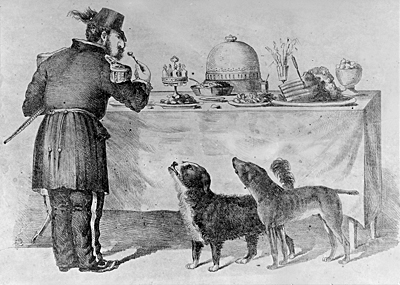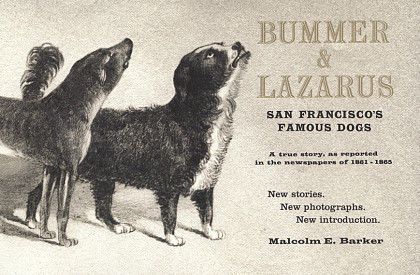|
Bummer and Lazarus: the Truth by Malcolm E. Barker OK. Let’s get this straight. Despite what you read on other websites, Bummer and Lazarus were not Emperor Norton’s dogs! I defy anyone to prove otherwise. They were strays, beholden to nobody. They roamed the streets of San Francisco in the early 1860s, exempt from a strict city ordinance that forbade dogs downtown without a leash and/or muzzle. Any other cur attempting this would have been bundled off to the pound, or shot on sight. They gained the respect and attention of the townsfolk because of their expertise at killing rats, and for their unique bond of friendship. Newspapers constantly reported their escapades, whether it was stealing a bone from another dog or stopping a runaway horse. When Lazarus died, one newspaper ran a lengthy obituary entitled “Lament for Lazarus.” While Bummer lay dying in the streets the local papers vied with each other in updating the news and Mark Twain added his characteristic caustic commentary. From these facts a number of myths have evolved. The most persistent is that the two dogs belonged to Joshua Abraham Norton, a local character who, from September 1859 through January 1880, roamed San Francisco claiming to be Emperor Norton I of the United States and Emperor of Mexico. Sadly, this myth continues to be espoused by historians and historical organizations that should know better. You’ll find it in their journals and on their websites. Of all the contemporary newspaper accounts of Bummer and Lazarus, not one mentioned Norton. In 20 years of newspaper stories about Norton, only one mentioned the dogs. That was when Norton saw in a store window a cartoon of himself eating at a free luncheon table with the dogs. He became so incensed that he struck the window with his cane, and broke the cane. The indignity of it — he, an emperor, eating with stray dogs . . . ! This incident, combined with any lack of substantiation in contemporary accounts, would surely seem to negate any possibility that Bummer and Lazarus were Norton’s dogs. Yet the myth persists!
At luncheon table The cartoon was one of several drawn by a young French artist, Edward Jump. Another cartoon of his depicted Bummer and Lazarus ambling along Montgomery Street at the heels of Norton, while yet another featured Norton giving the blessing at Lazarus’ funeral while Bummer looked on, mournfully.
For Jump, these were satires of the
time -- figments of his creative imagination. But future observers
saw them as depicting actual events. These presumptions have been
repeated by succeeding generations of writers and storytellers and
now are so engrained in the psyche of many San Franciscans that any
suggestion to the contrary is summarily dismissed.
In 1984, I gathered in one book all of the known contemporary newspaper accounts of Bummer and Lazarus. That book, Bummer & Lazarus: San Francisco’s Famous Dogs, has been re-issued in essentially the same format but with stories of other dogs well known to nineteenth century San Franciscans but now forgotten.
Ambling along Montgomery Street I realize that just because a story appears in a newspaper it doesn’t mean it is true. I am aware that the style in which some of these accounts were written indicates that the writers were unashamedly stretching the truth to add color to an otherwise insignificant event. To me, these embellishments are more acceptable than those that have since been added because they belong to the period; they provide us with a glimpse into mid-nineteenth century humor and tolerance. They become facets in the kaleidoscope that was San Francisco in the mid-1860s. I once read somewhere that a dog’s best friend is not man, but another dog. The unique bond of friendship displayed by Bummer and Lazarus certainly was a good example of this. Their story, as recorded in the newspapers of 1860s – faithfully reprinted in Bummer & Lazarus: San Francisco’s Famous Dogs – is indisputable proof that these two dogs deserve their own chapter in San Francisco’s colorful history without any help from a man who had delusions of being an emperor! |


